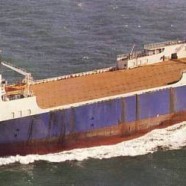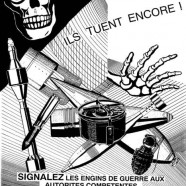Destruction of Syrian Chemical Weapons n°2
Neutralizing Syrian chemical weapons on board the Cape Ray, a cargo ship converted into an industrial platform, situated in international waters will make it possible to avoid national regulations.
This worldwide first will transform the high seas into a free zone, free from any democratic controls and environmental and social constraints. The OPCW and the United States state that 500 tonnes of Syrian’s priority substances will be treated at sea in a couple of weeks whereas the final destruction of America’s chemical weapons will not be finished before 2023. On land, the United States is hoping to treat 3,100 tonnes in 10 years. At sea, they are convinced that they can treat 500 tonnes within 4 weeks.
Destruction of Syrian Chemical Weapons
Update January 3, 2014 – 10:15 AM
Treatment of Syrian chemical substances onboard the American ship Cape Ray is a default solution. It follows Northern European countries’ refusal to directly dispose of the precursor chemical ammunition in specialized facilities (*). This operation on the high seas would install industrialization of the world’s oceans.
How Does France Manage Old Chemical Weapons?
Update
October 14, 2013 : a ministerial decree permits ASTRIUM to build SECOIA at Mailly-le-Camp.
—————————–
For 13 years, Robin des Bois has been working on the war waste issue including chemical weapons. Considering the current state of development it seems useful to review the doctrine and the actual practice of France in relation to the international Convention on the Prohibition of the Development, Production, Stockpiling and Use of Chemical Weapons and on their Destruction known as the Chemical Weapons Convention. The majority of chemical weapons to be destroyed on French territory were made with phosgene and chloropicrin, mustard gas and chlorobenzene, zinc tetrachloride, arsenic and cyanide.
Waiting for the bomb squad – War Remains Inventory from January 1, 2008 to December 31, 2011
Contents
Introduction
The unsettling truths – The battlefields of northern and eastern France – Old weapons kill – Old weapons pollute – Old weapons harm flora and fauna – Chemical weapons
War Remains Inventory from January 1, 2008 to December 31, 2011 with maps:
Franche-Comté Region
Alsace Region
Lorraine Region
Champagne-Ardenne Region
Ile-de-France Region
Picardie Region
Nord – Pas-de-Calais Region
Summary map
Sources
Introduction
War remnants do not have a course. Old weapons kill, pollute, and are the enemies of biodiversity. Following their previous research, Robin des Bois has published a new inventory of weapons discovered in the 7 regions in the north and east of France, casualties of the wars of 1870, 1941-18, and 1939-45.
Open letter about a secret
“Public archives may not be consulted if their disclosure is likely to result in the dissemination of information enabling the design, manufacture use or location of nuclear weapons, chemical weapons or any other weapons with direct or indirect destructive effects of a similar level”.
This paragraph, insidiously slipped into the middle of the bill on reforming access to archives currently being examined by the Senate and the National Assembly, undermines the safety and security of future generations, the regulatory framework on polluted sites and the “Convention on the Prohibition of the Development, Production, Stockpiling and Use of Chemical Weapons and on their Destruction”.












